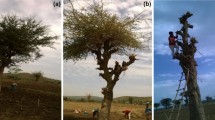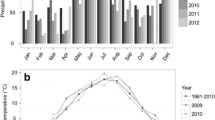Abstract
On-farm trials were conducted to assess the effects of four branch pruning levels on maize grain yield, tree growth and stem shape. The experimental plots consisted of Gmelina (Gmelina arborea R.Br.) trees planted at 1 × 10 m with maize intercropped in the 10 m-wide alleys between lines of trees. Pruning levels consisted of retaining a live crown ratio of 60–70% (T 1), 40–50% (T 2); 30–40% (T 3) and of 20–30% (T 4). At the end of the experiment, the total maize grain yield was highest under the high pruning intensity (T 4) (18.06 t ha−1) and lowest under T 1 (14.48 t ha−1). Maize grain yield under the pruning regime T 2 and T 3 were 16.08 and 17.21 t ha−1, respectively. Mean annual increment (MAI) in tree diameter was greater (5.0 cm year−1) under T 1 than those at T 4 (4.1 cm year−1). Pruning regimes T 2 and T 3 resulted in a MAI of 4.7 and 4.5 cm year−1, respectively. Financial analysis showed that maize-tree systems under T 4 were more profitable than under T 1 as long as the reduction of the average dbh at harvest were not greater than 1 cm. Pruning trees intensively also generated greater returns from labour than moderate pruning, as the greater maize grain yields under T 4 compensated for the cost of pruning and the lower timber yield. In the context of resource-poor farmers, intensive branch pruning was a practice that prolonged the period of profitable intercrop** and was compatible with commercial timber production.



Similar content being viewed by others
References
Ahmed P (1989) Eucalyptus in agroforestry: its effects on agricultural production an economics. Agrofor Syst 8(1):31–38
Beer J, Ibrahim M, Schlönvoigst A (2000) Timber production in tropical agroforestry systems of Central America. In: Proceedings of the XXI IUFRO world congress 2000: forest and society: the role of research, sub-plenary sessions, vol 1, pp 7–12, Kuala Lumpur
Bertomeu M (2004) Smallholder timber production on slo** lands in the Philippines: a systems approach. World Agroforestry Centre, Southeast Asia Regional Research Programme, Manila
Bertomeu M (2006) Financial evaluation of smallholder timber-based agroforestry systems in Claveria, Northern Mindanao, the Philippines. Small-scale forest economics. Manag Pol 5(1):57–82
Bertomeu M (2008) Can smallholder tree farmers help revive the timber industry in deforested tropical countries? A case study from southern Philippines. In: Snelder DJ, Lasco RD (eds) Smallholder tree growing for rural development and environmental services: lessons from Asia. Springer, The Netherlands, pp 177–191
Franzel S, Scherr SJ, Coe R, Cooper PJM, Place F (2002) Methods for assessing agroforestry adoption potential. In: Franzel S, Scherr SJ (eds) Trees on the farm: assessing the adoption potential of agroforestry practices in Africa. CABI Publishing, ICRAF, Nairobi, pp 11–35
Gajaseni J, Jordan CF (1992) Theoretical basis for Taungya and its improvement. In: Jordan CF, Gajaseni J, Watanabe H (eds) Taungya: forest plantations with agriculture in Southeast Asia. CAB International, Wallingford, pp 68–81
Garrity DP, Soekardi M, Van Noordwijk M, De la Cruz R, Pathak PS, Gunasena HPM, Van So N, Huijun G, Majid NM (1996) The Imperata grasslands of tropical Asia: area, distribution and typology. Agrofor Syst 36(1–3):3–29
Gonzal DR (1994) Gmelina arborea-annual crop interactions in contour hedgerow systems for smallholder farm forestry. Dissertation, University of the Philippines, Los Baños
Jordan FC, Gajaseni J, Watanabe H (eds) (1992) Taungya: forest plantations with agriculture in Southeast Asia. CAB International, Wallingford
Kapp GB, Beer J (1995) A comparison of agrisilvicultural systems with plantation forestry in the Atlantic lowlands of Costa Rica, part I. Tree survival and growth. Agrofor Syst 32(3):207–223
Kenmore ZF, Flinn JC (1987) An ethnohistory of an upland area: Claveria, Misamis Oriental. International Rice Research Institute (IRRI), Manila
Kerr G, Morgan G (2006) Does formative pruning improve the form of broadleaved trees? Can J For Res 36(1):132–141
Leiva JM, Borel R (1994) Evaluación de tres especies forestales en plantación pura y sistema taungya: crecimiento de los árboles y producción de los cultivos. In: Evans DO, Szott LT (eds) Nitrogen fixing trees for acid soils, nitrogen fixing tree research reports special issue 1995. NFTA, Turrialba, pp 85–93
Magbanua RD, Garrity DP (1988) Acid upland agroecosystems: a microlevel analysis of the Claveria research site. In: Proceedings of the 1988 acid upland research design workshop. International Rice Research Institute (IRRI), Los Baños, pp 1–20
Malik RS, Sharma SK (1990) Moisture extraction and crop yield as a function of distance from a row of Eucalyptus tereticornis. Agrofor Syst 12(2):187–195
Manurung GES, Roshetko JM, Anggakusuma D, Pramono AA, Heriansyah I, Fauzi A (2009) Smallholder teak-based farming management in Gunungkidul, Yogyakarta: current practices, obstacles and improvement options. In: ACIAR project report, improving economic outcomes for smallholders growing teak in agroforestry systems in Indonesia. World Agroforestry Center (ICRAF), Bogor, p 24
Martin FS, van Noordwijk M (2009) Trade-offs analysis for possible timber-based agroforestry scenarios using native trees in the Philippines. Agrofor Syst 76(3):555–567
Martin FS, Lusiana B, van Noordwijk M (2010) Tree growth prediction in relation to simple set of site quality indicators for six native tree species in the Philippines. Int J For Res. doi:10.1155/2010/507392
Miah MDG (1993) Performance of selected multipurpose tree species and field crops grown in association as affected by tree branch pruning, Dissertation. Central Luzon State University, Muñoz, Nueva Ecija
Nissen TM, Midmore DJ, Keeler AG (2001) Biophysical and economic tradeoffs of intercrop** timber with food crops in the Philippine uplands. Agricult Syst 67(1):49–69
Okorio J, Byenkya S, Wajja N, Peden D (1994) Comparative performance of seventeen upperstorey tree species associated with crops in the highlands of Uganda. Agrofor Syst 26(3):185–203
Ong CK, Black CR, Marshall FM, Corlett JE (1996) Principles of resource capture and utilization of light and water. In: Ong CK, Huxley P (eds) Tree–crop interactions: a physiological approach. CAB International, Wallingford, pp 73–158
Roshetko JM, Mulawarman, Purnomosidhi P (2004) Gmelina arborea—a viable species for smallholder tree farming in Indonesia? New For 28(2–3):207–215
Santiago RG (1997) Livelihood enhancement through agroforestry (LEAF) program. In: Developments in agroforestry research. International Center for Research in Agroforestry (ICRAF), Los Baños; Food and Agriculture Organization/Asia-Pacific Agroforestry Network (FAO-APAN); Natural Resources Management Program (NRMP-GOP); Philippine Council for Agriculture, Forestry and Natural Resources Research and Development (PCARRD); Department of Science and Technology (DOST). Book Series No. 160/1997. Los Baños, pp 45–56
Saxena NC (1991) Crop losses and their economic implications due to growing of eucalyptus on field bunds—a pilot study. Agrofor Syst 16(3):231–245
Shiva V, Bandyopadhyay J (1987) Ecological audit of eucalyptus cultivation. Research Foundation for Science & Ecology, Dehra Dun
Smith DM (1962) The practice of silviculture, 7th edn. Wiley, New York
Virtucio FD, Uriarte M, Tandug LM, Pinol M, Lasmarias VT (1986) Determination of taper and bark thickness of commercial tree species, terminal report. Forest Products Research Institute (FORI), Los Baños
Watanabe H (1992) Tree–crop interactions in Taungya plantations. In: Jordan CF, Gajaseni J, Watanabe H (eds) Taungya: forest plantations with agriculture in Southeast Asia. CAB International, Wallingford, pp 32–43
Author information
Authors and Affiliations
Corresponding author
Rights and permissions
About this article
Cite this article
Bertomeu, M., Roshetko, J.M. & Rahayu, S. Optimum pruning intensity for reducing crop suppression in a Gmelina–maize smallholder agroforestry system in Claveria, Philippines. Agroforest Syst 83, 167–180 (2011). https://doi.org/10.1007/s10457-011-9435-y
Received:
Accepted:
Published:
Issue Date:
DOI: https://doi.org/10.1007/s10457-011-9435-y




